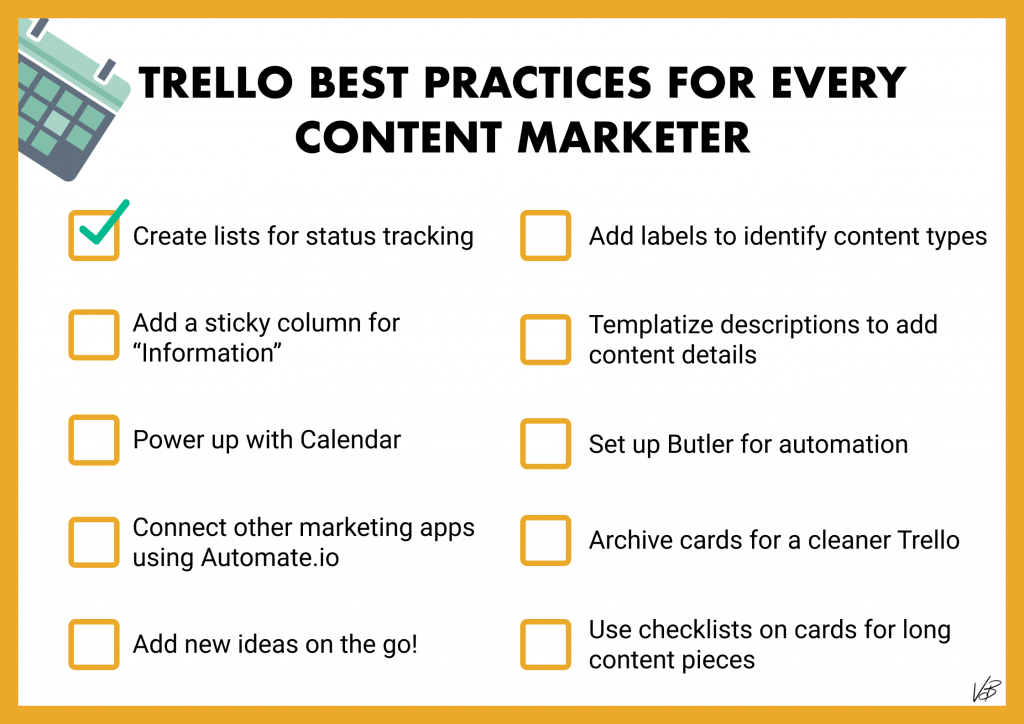Learn all about using Trello for content marketing, content marketing templates and managing content calendars on the project management tool.
B2B content marketing involves a lot of heavy lifting. From different types of content to extensive content marketing strategies to SEO, the average content marketer has multiple content projects to juggle. But, your content marketing management can be made simpler with one tool that most successful content marketers swear by— content calendars.
In this blog, I want to help you set up a content calendar for all your B2B content marketing efforts using Trello – which is a personal favorite and the team’s loving it too for work management.
So without further ado, let’s dive into why you need a content marketing calendar, how you can get started with Trello, and the best practices to make Trello work for you.
Importance of a Content Calendar
One of the biggest pain points for content managers is being able to manage multiple content projects at one time.
Spreadsheets are limiting for your daily use, with no way for content marketers to view the different projects at once, along with their details. Spreadsheets make it tough for content teams to manage their work in real-time.
You can solve your content management needs with a content calendar. A well-designed content calendar keeps you organized, with every piece of information in one place. The calendar acts as a dashboard, simplifying the way you approach content marketing strategy.
A calendar also lets you entertain potential blog ideas in one place and ideas for your brainstorming sessions will never get lost on post-it notes.
Content teams need to be consistent with their publishing but without a calendar, you may end up missing a week or even miss out on an opportunity to tie your content with an upcoming holiday.
Unlike a spreadsheet, a content calendar creates visibility in the tasks on someone’s plate. This way, managers won’t over-assign work to a writer/editor. This visibility also helps the social media team to plan their social calendar ahead of time and avoid clashes in their schedule.

Oh, and while you’re at it, don’t forget to read these content marketing myths that are making you lose customers.
Trello for creating a B2B Content Marketing Calendar
Trello is used by top companies like Foundr and Buffer. This smart project management tool has a kanban board layout that gives you an extensive overview of all the work and their status, in real-time.
Each Trello board can have multiple columns or “lists” where cards are organized. These lists can be month-based or separated by the card’s status, based on your preference.
Trello lets you break down your work into smaller tasks with cards. For content marketers, these cards on Trello would be blog topics that need to be written.
You can further break down tasks within each card by adding a checklist. Cards can be assigned to multiple team members and you can add more details to the cards, like due date, labels, attachments, etc.
Trello is perfect for teams working on multiple projects and stakeholders at once since the smart tool adapts to your project management needs and goals. You can see how different marketing teams use Trello through the content marketing templates here.
5 Steps to Getting Started with a Trello Content Calendar
1. Set up your lists
Your first task when setting up a content calendar on Trello is to define the lists that your cards will be placed within. The default category for these columns is status. This way, you organize all blog cards by 6 status categories— blog ideas, to do, in progress, editing, scheduled, published. You can also add columns for blogs that need updates or SEO edits.
An alternative list of categories is by month. Some content marketers using Trello categorize their cards by month. This way, cards are viewed by priority and columns of past months move past the vertical page fold.
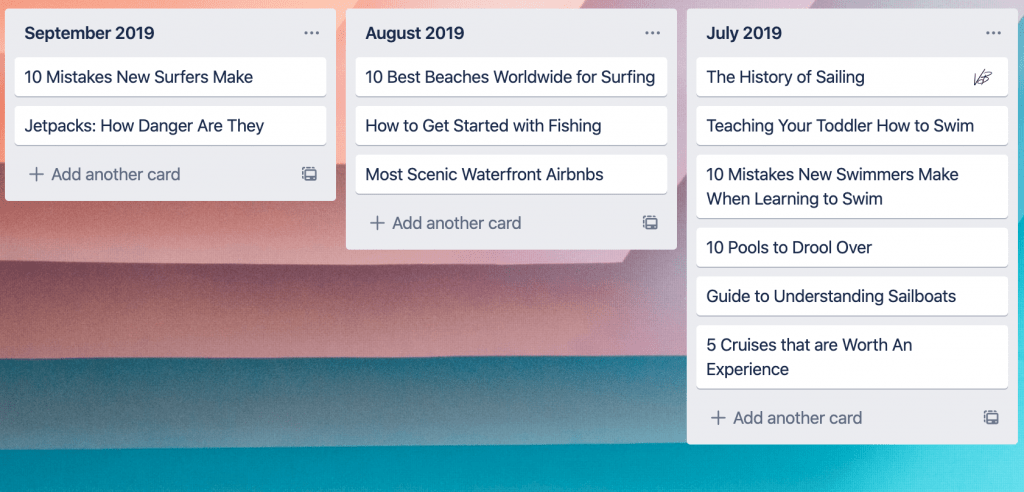
One Trello recommended idea when setting up your columns is to add “Information” as your first list. Under this column, you can attach your keyword lists, content audit spreadsheet, buyer persona, writing guidelines, card template, etc. Unlike the rest of your board, this column and its cards will be fixed.
2. Use labels as identifiers for the blog
Labels are a nifty feature on Trello. This feature lets you add important information to the blog card so that anyone looking through the calendar gets an overview of how the blogs are categorized. Use these labels to smartly categorize your blogs.
Think of what category is most important for your blog— primary keyword, content type, or customer persona.
Set up labels from the get-go so that writers get used to this new system can add labels as they create new cards.
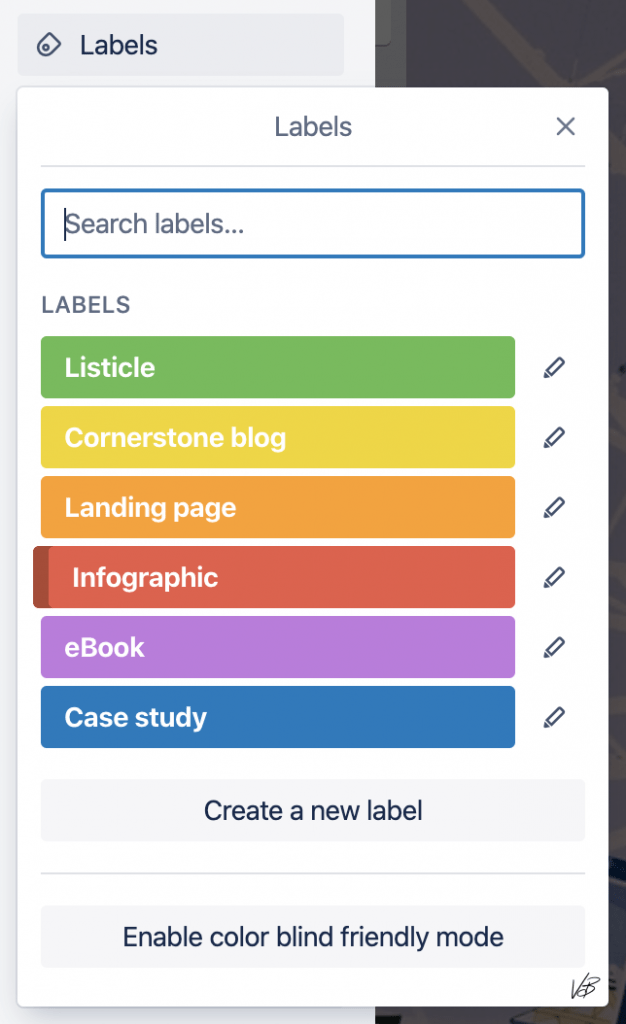
3. Create a content marketing template for blog card description
The description property within each card is commonly used by content marketers on Trello to add more details about the blog. This includes keywords, blog outline, word count requirements, customer persona, content type, and more.
One of the most efficient ways to use Trello is to templatize the description section so that stakeholders can easily replicate and fill in important details. This template also allows writers to fill in every detail about the blog so that when they do sit down to write it, they don’t miss out on the crucial ideas.

4. Introduce this system to your team
This one’s a no-brainer! Once you’ve set up the basics on your Trello content calendar, introduce the system to every stakeholder involved and get them used to the board, Trello is easy to navigate so your team won’t have a hard time getting started.
Walkthrough your template and show them an example of an existing card, how to move cards across statuses, and any guidelines you have to run your Trello board smoothly.
If you need help setting up a content marketing template on Trello for better project management, you can reach out to Contensify.
5. Make Trello your default content management system
Once you’ve transitioned your content calendar onto this smart project management tool, it’s best if you make this content board your default place to view, manage, and modify blog ideas. Purge any extensive spreadsheets that you used to use for content management.
Once you’ve gotten used to Trello, you’ll find it easy to monitor your day-to-day content tasks.
Content Calendar Examples for Inspiration
While you’re setting up your content marketing calendar on Trello, I wanted to give you some inspiration so that you can get more ideas on how to structure your kanban board and customize it to make it your own.
Here are 3 content marketing calendar examples on how you can use Trello for your B2B content planning:
1. Foundr
Foundr has its own style of content management on Trello. They don’t follow a status format for their columns. Instead, the columns define what bucket blog post falls under.
Why it works: Foundr prioritizes its social media posts as much as its articles. So, they add weekly social columns that keep every kind of content effort in one place.

2. eCommerce blog
Here’s an example Trello board that shows how an eCommerce-centric blog organizes its cards. Just like Foundr, this board doesn’t conform to status-driven columns. Instead, cards are organized by month.
Why it works: Since the blog is managed by one person, status sharing isn’t a priority. They use labels for status updates and to tag which social media channels it has been shared on.
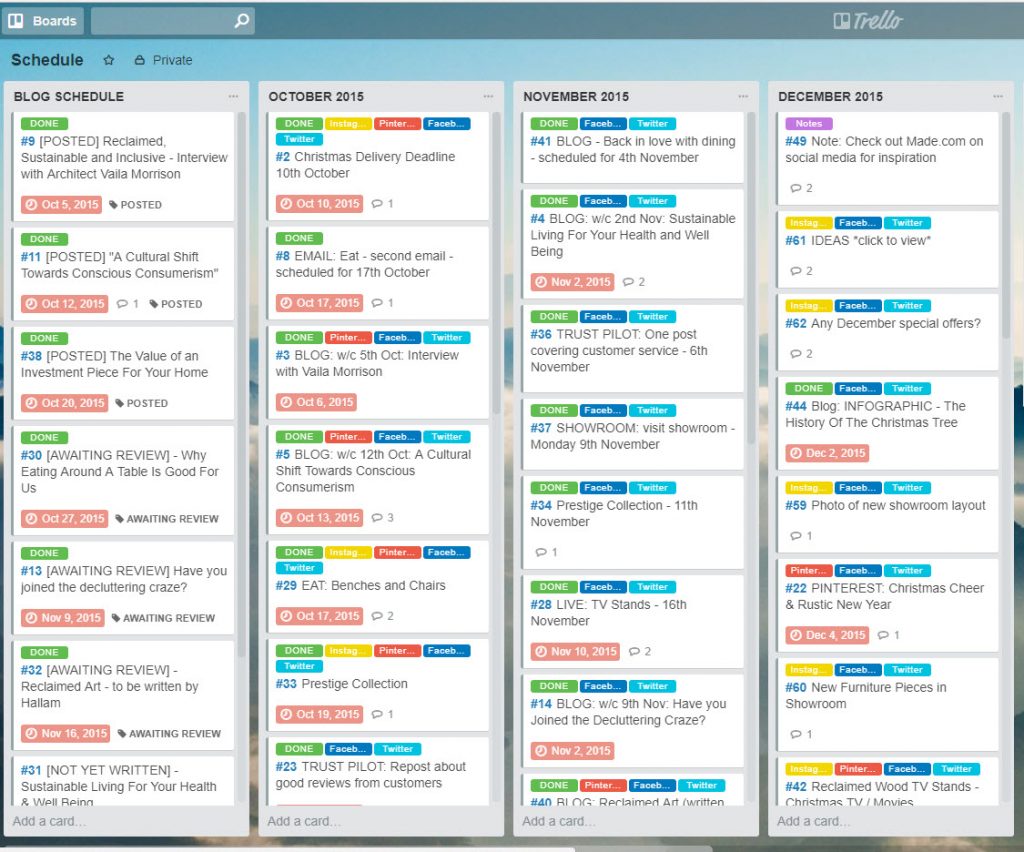
3. Trello recommended
According to Trello, this is how they recommend a layout for editorial content calendars. They created columns based on the status of the content.
Why it works: Trello has added a column for information. This column can be used to note down writing guidelines and templates. You can make the content audit, buyer personas, and keyword lists easy to access by adding this information column.
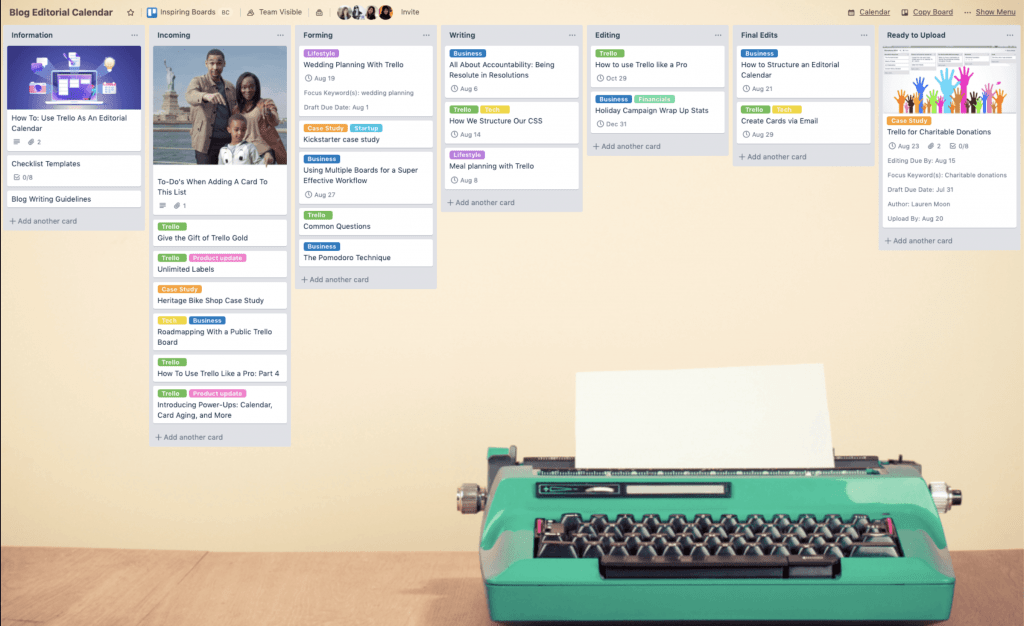
How Buffer Uses Trello for B2B Content Marketing
Buffer has 2 blogs that they manage— the open blog that takes about company and culture, and the social blog that gives all the best tips on social media marketing and small business management.
Trello allows Buffer to plan out their blog topics based on their status and managers can see details about each topic and understand its progress in real-time. Writers can easily move their blog cards across the lists.
For their social blog calendar, Buffer has 9 lists that define the status of each blog idea:
1. Content ideas
This list has every idea that the Buffer team comes up with and exists like a dump of content ideas.
2. Pipeline (ready to be written)
The ideas that are selected for future publishing are moved to the pipeline column. Each card in this column contains a description of the post, keywords the team is targeting, personas, topic, and more.
3. Content to relaunch
This column shows all the blogs that need a complete edit of the content. Unlike a blog that needs to be updated, these blogs are redone for SEO purposes and they are republished with a new publish date.
4. In progress
This column has all the blogs that are currently being written by the writers at Buffer.
5. Editing
Blogs written by one team member are usually reviewed by a second person to catch any errors and polish the piece for publishing.
6. Ready to ship
This column has all the blogs that are ready to go out and have been scheduled with a publishing date on the blog’s backend.
7. Shipped
This list shows all the blogs that are published already. Items on this list sometimes move to the “updates needed” column.
8. Updates Needed
As social media is constantly changing its rules and how it works, it’s crucial that Buffer’s content is up to date with the latest changes. This list helps the team to identify blogs in real-time that need edits so their content is never stale.
9. User requested content
Buffer has a large following so, readers and product users often request for certain kinds of content to help them understand a concept or use a feature in their product.
This extensive content management dashboard allows Buffer to keep their content updated, stay on top of deadlines, and effortlessly manage multiple writers.
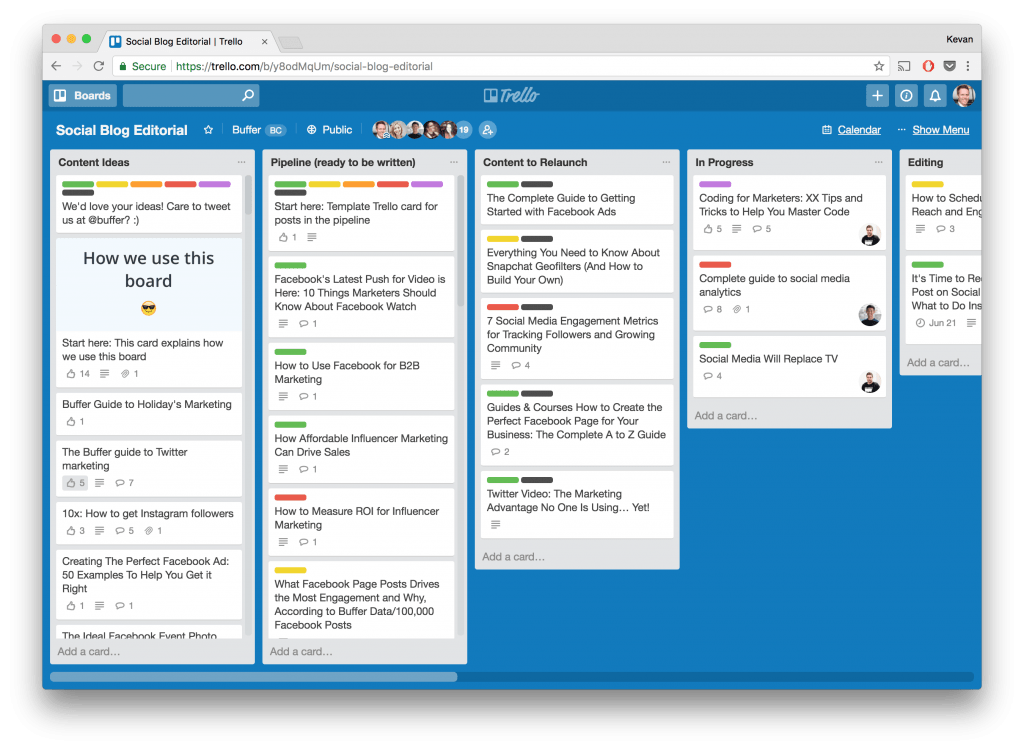
Best Practices for Using Trello for B2B Content Marketing
Now that you know how to get started with B2B content marketing on Trello, it’s also important that you have systems and practices in place that compliment your editorial strategy and help you strategize monthly content pieces in a data-driven and smart manner.
1. Audit of your past blogs on a monthly basis
A monthly audit of all your content marketing efforts allows you to understand the types of content you have created, which stage of the customer journey your target audience is, and how the page performed.
Auditing your content’s performance can help you understand which important keywords you are making progress with, keywords that you need to prioritize next, and the gaps in your content topics. This way, you can identify problems and implement solutions in the next year.
For instance, marketers can analyze the bounce rate to understand how they can optimize the blog to increase reader engagement. Simply put, a content audit allows you to continually improve your content marketing strategy.
Here’s what a content audit would look like:

The details of your content pieces can be collated on a spreadsheet by you or you can even automate this work. Tools like Screaming Frog automatically crawl your website to collect URLs, title tags, and other details.
Once you’ve audited your content, your monthly auditing task gets simpler— just add new blogs from the previous month, update the page metrics, and note the keywords that made your blog search-friendly.
You can consider the different details about the content that you want to add to your audit sheet. These are the most common details that content marketers add to their content audit— page title, content type, URL, author (if there are multiple), targeted customer stage, page visits, bounce rate, primary keyword, conversion rate.
You can choose the metrics you want to add to your audit based on your goals, whether it’s more social shares or more CTA clicks. These metrics can be easily taken from Google Analytics.
This content audit functions as your content dashboard to help you access your content performance on the go.
2. Research and prioritize keywords for quicker planning
Before you start planning your content pieces, the first priority is narrowing down your keywords. Tools like SEMRush have made it easy for marketers to find and understand relevant keywords and their performance. There are 3 types of keywords that you need to focus on when planning your blogs.
1. Existing keywords: These are keywords that your blog posts have already ranked for. With these keywords, you would want to get to the top position of the search engine.
2. Popular keywords: Your aim with using keywords is to rank high on the most commonly used keywords by your potential readers. List all common keywords (and their variations) and your monthly position so you can include them in your content strategy, allowing you to maximize your reach.
3. Competitor keywords: Understanding how your competitors are performing is crucial to help you get ahead. Compare their best ranking keywords (and their corresponding blog posts) against your position with the keyword.
Create spreadsheets of each of these keyword types to monitor your performance over time and strategize your blogs to rank higher. For each of these keywords, track the volume of searches and how you have ranked for it in the previous months.
Once you’ve set up these keyword lists, you can update them monthly and use them to plan and prioritize content ideas for the coming month.
Need help in getting started with keyword research for B2B content marketing? Let’s talk.
3. Define your buyer persona and their stages
Buyer personas are a way for content marketers to understand who they are writing for and what the objective of that content is. By defining your personas, you can plan and prioritize your content pieces better and create content that converts.
Your personas can be as defined by their industry, the size of their company, the problem they are trying to solve, what keywords they use, and what language they respond to.

For instance, if your product is a work management tool, one buyer persona might be a small business owner in the finance industry trying to streamline his multiple projects and employees. Another persona might be an enterprise business that needs a work management dashboard that keeps all the details of the work in one place.
Read more about buyer personas for content marketing.
4. Maximize Trello with their properties
Just like any Kanban board, you can pack your blog cards on Trello with details about the post. It’s crucial for content managers to be able to understand how each blog is progressing and be able to identify why it’s being written, whether it has any roadmaps and the target audience for the piece.
I recommend making use of the following properties to pack your content marketing calendar with information:
1. Members
Ensure each card has a “member” assigned who is the owner of the blog. If there are design requirements, don’t forget to add the designer who will be creating the assets.
2. Due date
Use the “due date” property to show when the blog will be published. This will give everyone an idea of when each blog is going out.
Ps. It also auto-reminds the owner of a task of an approaching deadline. It definitely keeps me on track!
3. Label
Content marketers don’t usually use the “label” feature but when used right, labels are a great way to allow you to get an overview of the details that matter. They show up on the card even when they are collapsed.
4. Description
Create a template so that writers can fill in the details of their blog idea— keywords, word count, customer persona, blog structure, and more.
5. Activity
The “activity” feature is essentially a comment section where people can chime in with remarks, suggestions, and questions about the specific blog. This way, all discussions about a particular blog is in one place.
6. Checklist
If your blog is extensive and has multiple stakeholders, Trello’s checklist feature allows you to add subtasks within each blog card. These subtasks can be infographic creation, image requirements, quotes from external parties, etc. Since these tasks require people from departments outside of content, the checklist feature will make it easier for you to manage and get them done.
5. Automate the small stuff with Butler
Butler is a smart automation assistant within Trello. With this smart feature, you can perform your common actions with just one click, create custom buttons, send a card to the member assigned to review your work, automatically sort cards by priority, archive cards within a specific list and more.
Butler even sends a reminder to the assigned person when a due date is near, a nifty feature that keeps people on track.
6. Explore power-ups
Trello integrates with your favorite apps to let you take full advantage of the calendar. With these “power-ups”, you can maximize your Trello board and keep all your work in one place.
Here are 5 of our favorite apps to add to our Trello board:
1. Unito
If you use Trello for other operations as well, Unito is a great way to cross-communicate requirements. Connect 2 individual Trello boards and work collaboratively. For instance, the support team may need a content piece on a certain topic and they can easily use Unito to set up this need.
2. Calendar
Since content is usually attached to a deadline, the Calendar integration lets you get a calendar view of every blog post. This makes it easy for stakeholders to visualize the upcoming content and social media managers can plan their posts ahead without hassle.
3. Google Drive
Connect your blog post draft within the card by integrating Google Drive. This also lets you collaborate with others in the team, edit drafts and insert newly created image assets.
4. Slack
This “power up” makes it easier to get reminders about due dates for blogs right in your communication app, get feedback about a project, get notifications for activities, and turn brainstorms into actionable items on your Trello.
5. Automate.io
With Automate.io integrated into Trello, you can integrate with all your apps to streamline your content management and distribution. For instance, you can add card details onto Google Sheets, making content audit simpler.
Automate.io connects your Trello board to your favorite CRM like Hubspot or Salesforce, and even social media tools like Buffer. Talk about bringing your sales and marketing efforts on the same page!
And voila! You’re all set to use Trello for B2B content marketing.
I hope Trello helps you set up a streamlined content marketing calendar. For years now, it has been my go-to when it comes to creating calendars for my team or the projects we work on.
So sign up on Trello and get going before that content idea slips out of your mind again! Let 2020 be the year when you rule inbound marketing!
Need help setting up Trello for B2B content marketing?
You can reach out to me any time or simply drop me a tweet and I’ll get in touch with you.


